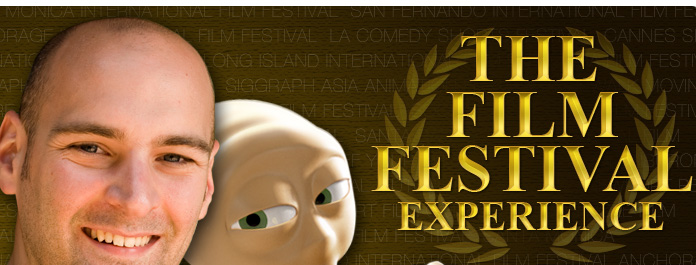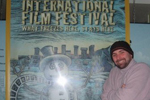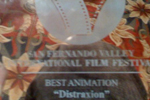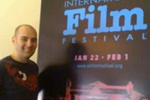

|

|

|

|

|

|
|
|
The Film Festival Experience – My Distraxion Tour
By Mike Stern The single biggest source of inspiration that enabled me to complete my short film Distraxion was the hope that at some point I would be able to play the film in front of an audience. I was fortunate enough to have that opportunity. Over the last year, I followed my film as it played in over 20 festivals. I attended over half of these festivals and I was able to see my film with various audiences, in several locations and under a range of different circumstances. Most of these experiences were positive, but some of them...well, not so much. Looking back now, I have found that navigating the film festival circuit is a learning experience in and of itself. Just like animation, there are different ways to approach it that can lead to different results. I had a such a broad range of experiences at the festivals I attended. At one festival, I was able to see Distraxion on an HD screen in a huge theater packed with hundreds of people. Then at another festival, I saw it on a screen that wasn't much larger than the average TV set. I was in a hotel lobby with less than 10 people, most of which were other filmmakers seeing their films. My other screenings fell somewhere in between these extremes. There are so many factors that contribute to a successful screening, and it helps to be aware of these factors so that you can go into the festival run armed with the right knowledge and expectations. I'm going to take some time here to share what I found to be the most important things to consider when taking your film to the festivals. Hopefully, this information will come in handy to filmmakers that are just about to start submitting.
What to Consider When You Submit to a Festival I would say that venue, audience, programming, and filmmaker recognition are the factors that determine whether a screening will be successful or not. In a best-case scenario, your film will be screened in a sufficient theater in front of an enthusiastic audience. It will be programmed within a block of other films that have similar production values and content and this film block will be in line with the audience's expectations. Finally, you will have a chance to discuss your film after the screening and also hear the other filmmakers talk about theirs. This is the ideal, but it is not always the case. I've found that there aren't really any guidelines as to what can be considered a festival these days. You could theoretically collect a bunch of films and plan to show them in your living room. If you put a website online and charge admission fees, you can call it a festival. As filmmakers making the investment to apply to festivals, it helps to do the research up front so that we can target the ideal festivals and avoid the ones that are just thrown together.
The Venue Affects the Experience The venue alone can make or break a festival. Fortunately, most festivals will list their venues online. If the venue is local, I would recommend that you go and see a screening there to see how it holds up. Hopefully, the theater staff will be organized and have a working method for getting people in and out of the screenings. The size of the venue is also important because it needs to match the size of the event. It's never fun to screen at a huge theater with only a few seats filled, or at a small theater that is packed so tight that people are uncomfortable. The projection is another variable that needs to be considered. Your film will look different on different screens. You can narrow down the margin of error by making sure to submit your film in the format that is ideal for the projection in the selected venue and to clearly mark your tape, DVD or file with the aspect ratio and any other details that the projectionist would need.
The Festival Audience The audience is obviously a huge factor in the success of any screening. Different types of festivals have different types of audiences. The larger festivals near the major cities usually have a big industry presence. This means that your film will be getting exposure to people who are working in the film industry, and the Q&A sessions will most likely be filled with very interesting and specific questions. The downside to these festivals is that they can be a bit impersonal at times. There are so many people, films and events that it can be easy to get lost in the shuffle. The remote festivals usually don't have as much of an industry presence, but they tend to have a very enthusiastic local interest. The venues are smaller, but they generally fill up quickly and the film fans are very vocal. I would have to say that two of my favorite screenings during the festival run had to be at the Arlington Theatre in Santa Barbara and at the Bear Tooth Theatre Pub in Anchorage, Alaska. These screenings represent the two ends of the spectrum. The Santa Barbara screening was in a huge theater. It was a total rush to come up on the stage to introduce the film even though I could barely make out a single face in the audience. On the other hand, the Anchorage screening was in a small theater with a pub in the back. The place was packed to the gills and the seats were filled with some of the most excited film fans I have ever attended a screening with. The block of shorts was titled Love and Pain, which totally set the stage perfectly for my film. This brings me to the next important factor after venue and attendance which is programming. Short film screenings are programmed in blocks and the films that play directly before your film have a great impact on the audience's expectations for your film. I found that some of my best screenings were the result of great programming. My film is a comedy, and the biggest responses I received were when my film followed another comedy. The screenings in which I followed a drama were less successful. There was even a festival where Distraxion was placed in the experimental film block, which was a big miss.
Filmmaker Recognition A big part of the festival experience is getting recognition for your work and to be able to recognize the great work of other filmmakers. Most festivals will establish contact with the filmmakers and know what screenings they are attending. They will also provide the filmmakers with passes for other screenings and special events. It is a big plus when festivals offer incentives, such as cash prizes and awards. Some festivals even offer prizes in the form of exposure and pitch meetings. When a film plays successfully at a festival, it is not unusual for the filmmaker to be contacted by developers, other filmmakers or collaborators wanting to know what's next. These are the factors that make for a great festival. Now the question is, how do you find out which festivals get these things right and how do you submit to them?
Selecting the Right Festival for Your Film At the beginning of a festival run, the process of selecting and submitting can be a bit overwhelming. It takes time, money and it can be very hit or miss. There are a lot of festivals and not only do you want to find the good ones, but you want to find the ones that are a good match for your film. The best approach is to do a lot of research up front and then continue to feel things out as you go along. Start by swinging for the fences. Pick out a few festivals that will be a reach. As animators, two of the "reach festivals" would be Annecy and the Ottawa International Animation Festival. These are really tough to get into, but an acceptance from either of these will say a lot about the quality of your film. Another resource for "reach festivals" would be the list of Academy qualifying festivals. A "Best Animation" win at any of the festivals listed here will put your film in consideration for an Academy Award. While most of us have more humble expectations for our films, this list represents festivals that are established enough to be recognized by the Academy and will present great opportunities for you to put your film in front of an audience. After submitting to some of the reach festivals, it may be time to start branching out. The next step could be to target festivals based on specifics. There are a bunch of genre-specific festivals. There are festivals for horror, comedy and sci-fi. The responses at these types of festivals are usually very positive because the audience knows what to expect and are obviously enthusiastic about the subject matter. There are also specific categories for entry at some of the larger festivals. I've found that I've had the most success with the larger festivals when there is a specific animation category as opposed to a blanket short film category. Applying in a short film category puts your work up against live action shorts, which in some cases can make it less likely to be considered. Once you have some festivals selected, it is good practice to go onto the festival website and check out some of the films that have screened the previous year. There is a lot you can learn about a festival just by watching the winning films. If you can find contact information for the filmmakers, reach out to them and ask for their take on the festival. This could help inform your decision about whether or not to apply.
The Application Process The actual application process requires some busywork. Most festivals will accept submissions online through the website withoutabox.com. This is a great time saver. The site lets you fill in your information once and send it to multiple festivals. They also have tools that let you browse through festival listings and set email reminders for upcoming deadlines. Using "withoutabox" is a great way to stay organized. Organization is of utmost importance when it comes to the submissions process. In addition to my "withoutabox" records I also keep a spreadsheet with a list of all the festivals I enter along with all of the details such as shipping dates, tracking codes, the type of submission screener I sent out, whether I was accepted or not, whether or not I was able to attend, and if my film won an award. When you send your submission whether it's online or through the mail, you will also need to pass along a copy of your film on DVD. I like to always have 10 DVD copies of my film burned and ready to go. As I send screeners out, I prepare new ones. Requests sometimes pop up out of nowhere, as do unexpected acceptances that require additional screeners. There have also been instances where I found out about a great festival with a deadline within a few days and it worked out well to have the DVDs all ready to go.
What It's Like to Attend a Festival Once those festival acceptance letters start coming in. It's time to start planning for attendance. A good first step is to get in touch with the program coordinator, especially if you are traveling to the festival. Sometimes you will be contacted directly by the coordinator but other times you will need to seek them out. The coordinator can usually provide you with specific information about your screening and the festival. Sometimes they will also put you in touch with other filmmakers in your category that are attending. Before you head to the festival, make sure to download the program and make an event schedule. Festival days are packed with screenings, Q&As, filmmaker panels and special events. You want to plan your days so that you get the most bang for your buck. Certain events fill up fast so you need to leave time in between each stop especially if the venues are spaced out. It's also a good idea to pick a few of the more open days just to explore the area. While you are attending the festival, make sure to reach out to other filmmakers, especially the ones in your block. It is much more fun to attend the screenings as a group. The majority of the highlights from my film festival experience involve the time I spent with other filmmakers sharing stories about film production and the experience of traveling through the festivals. It's also a good idea to ask the filmmakers that you meet what their favorite festival was. This is a great way of getting some solid recommendations to add to your festival watch list.
Picking and Choosing Your Festivals As your film plays at more festivals and starts to get recognition, a lot of times you will start to get invitations to screen at other festivals. In most cases, the entry fee will be waived which is great because those fees add up over time. You will also find your criteria for selecting festivals will once again become more refined. One thing I found was that I was not getting much value from the festivals that Distraxion was accepted to that I could not attend. At that point, I stopped applying to festivals that were out of my range for travel or would not fit into my schedule. The exception to this was the Short Film Corner at the Cannes Film Festival. Distraxion was selected for a public screening at the Short Film Corner, and while I would have loved to attend, I was not able to rearrange my schedule in order for that to happen. I was still able to get a lot of value out of this festival because of the viewing reports that were sent over email. Each day I received updated information about who had seen my film as well as their contact information. Most of the viewers also reached out with their own personal messages and offered me some great feedback on the film. Several festival programmers attended the Distraxion screening at the Short Film Corner and as a result the film was invited to some additional festivals without going through the admissions process.
Reading the Filmmaker Agreement There are a few things to be careful about when applying to festivals. Most festivals will make you sign a filmmaker agreement. It is important to read and understand what you are agreeing to when you submit your film. If there are any questions, it's better to ask than to just sign. Most of these agreements make sure that you have the rights to the content in your short film and that you grant the festival the rights to screen it, but there are a few places where things can get tricky. Some festivals ask for permission to use clips of your film for the purposes of promotion. I usually grant this permission. However, when an agreement asks for publication rights for festival "best of" DVDs or online display, in most cases I avoid it. Displaying your film publicly online, even on your own terms, is something that you need to be careful about if you plan to make an extended festival run. A lot of festivals will disqualify films that are available online. It is in the festival programmer's best interests to display fresh content and not films that are available for free over the Internet. In my opinion, it is best to play it safe and wait until after the festival run is winding down before you post the film online. Another thing to consider carefully is your premiere. You should try to shoot for a premiere at one of your reach festivals. Festival programmers will give special consideration to films that are making their premiere. It will also mark the start of your festival season. The life of a festival run is usually just a little bit over a year so it is important to consider which festivals you want to hit early in the run vs. later. Overall, the festival run with Distraxion has been a great success. The film clocked more mileage than I ever could have expected. I've had the opportunity to travel to some amazing places and see sights and inspiring films that I would have otherwise never been exposed to. I was also able to meet a bunch of like-minded, talented people that share a passion for the art of filmmaking. As most filmmakers will attest, the process of producing a short is not an easy task and taking a festival run with your finished film is truly a great payoff for all of the hard work.
To see how Distraxion was made, click here. Mike Stern is a graduate of Animation Mentor, a character animator at DreamWorks Animation and a mentor at Animation Mentor. For updates on Distraxion, check out the Facebook Fan Page. For more information on Mike, check out his blog: www.sternio.com |
|







